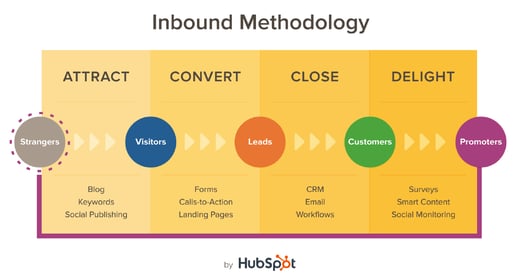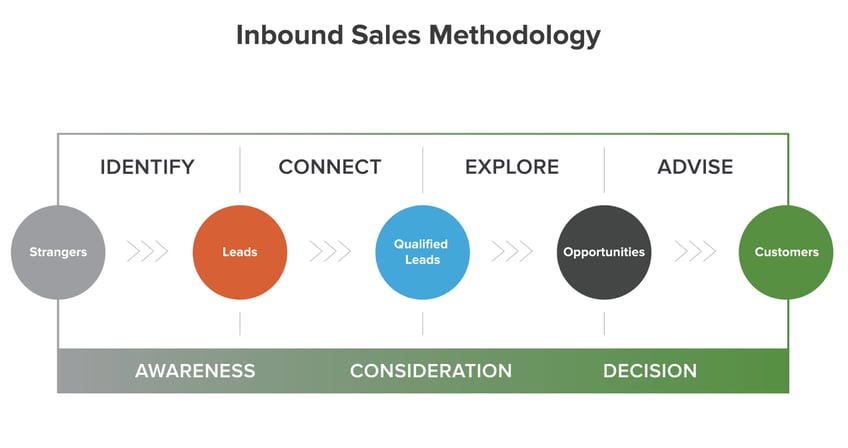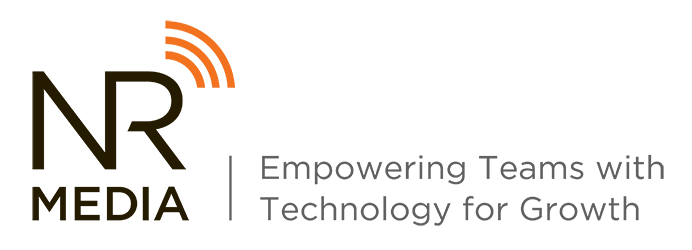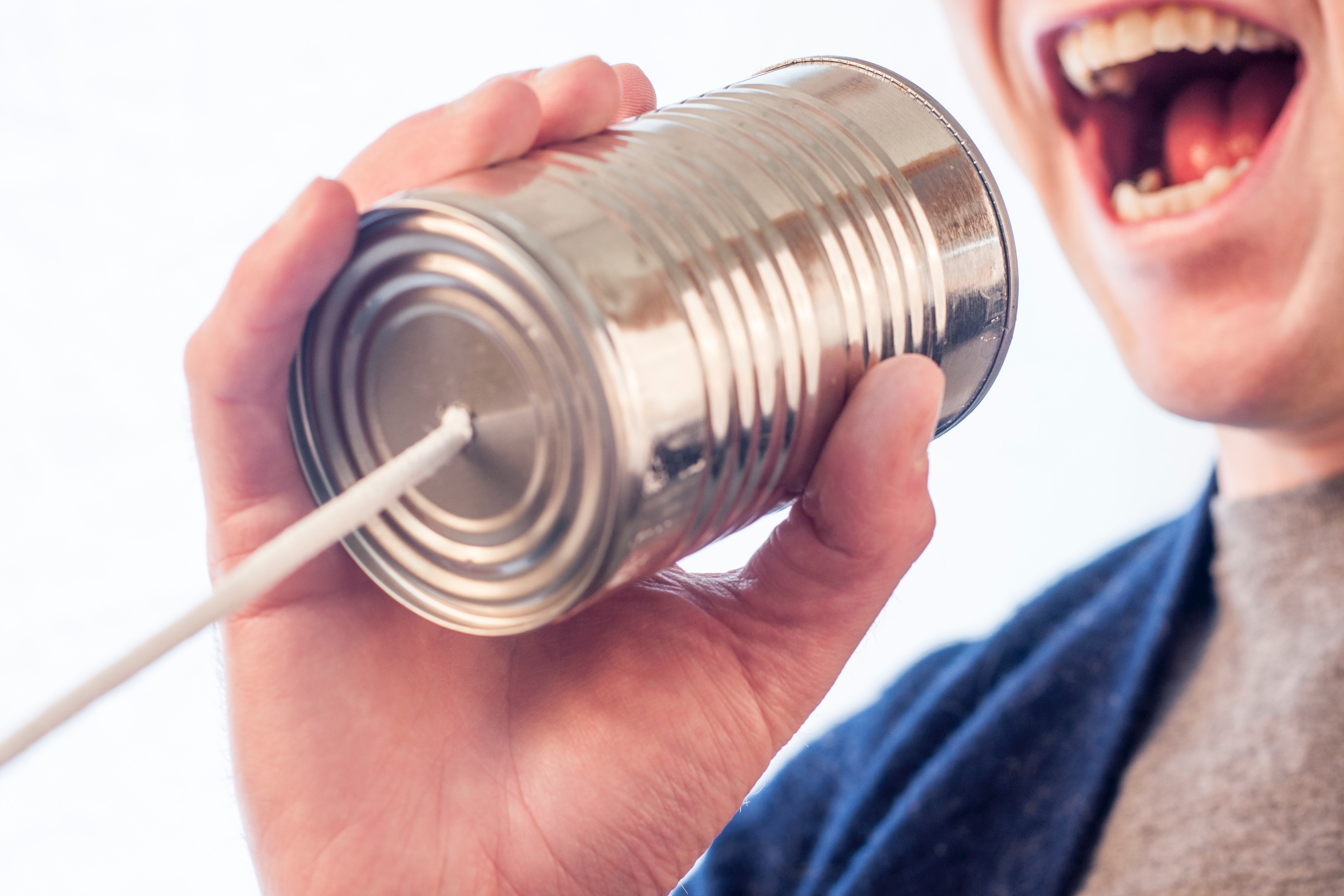 Many of you are probably familiar with HubSpot's Inbound Methodology.
Many of you are probably familiar with HubSpot's Inbound Methodology.
If you have taken HubSpot's Inbound Marketing Certification, you should really know the Inbound Methodology like the back of your hand. They only include it in just about every class on at least 10 different slides.
However, in case you need a refresher: the Inbound Methodology outlines the process that us inbound marketers use to transition a "stranger", or a new website visitor, into a "promoter", also known as a brand advocate.
The Inbound Methodology includes four stages: Attract, Convert, Close, Delight. Each of the four stages includes a list of content options that lend a hand in the transition from one stage to another.
For a long time, the Inbound Methodology has had free reign as THE prevailing methodology of HubSpot. But there's a new methodology in town.
The Inbound Sales Methodology
HubSpot unveiled the Inbound Sales Methodology along with their new certification, the Inbound Sales Certification.

Remind you of anything? HubSpot wisely built off of the existing methodology format to make this new methodology more digestible.
***Side-note: I will say that I think it was a good call on their end to integrate the buyer's journey into the bottom section of the graphic. It brings everything full-circle very nicely and neatly.***
So What is the Inbound Sales Methodology?
The Inbound Sales Methodology is the gateway to selling in an inbound way. That means you're going to have to pack up your purchased list of phone numbers all prepared for cold-calling by your poor "marketing interns". And take a chill-pill with the demos. But alas, I'm getting ahead of myself.
Is your organization new to inbound marketing, but you think it would be a good fit?
Check out our Inbound Readiness Workshop!
The Four Stage Sales Process
Similar to the Inbound Marketing Methodology, this new methodology revolves around four stages. Those four stages are designed to nurture someone from the "strangers" stage in the relationship to the "customers" stage in the relationship
The four stages of the Inbound Sales Methodology are:
-
Identify:
In the identify stage of the methodology, the inbound salesperson will identify which individuals would benefit from purchasing their product or service. If you're still thinking you can be an inbound salesperson and purchase cold-calling lists, this is where you should stop thinking that.
The identify stage asks the salesperson to go out into the world and qualify the right strangers based on certain clues. These clues include blogs their current buyers are following, LinkedIn groups their current buyers belong to, and thought leaders that their current buyers follow on Twitter.
As the inbound salesperson is monitoring these clues to determine who might benefit from purchasing their product, they are prioritizing individuals who are "active" buyers, that is, individuals who are currently working through the buyer's journey. These active buyers are typically more qualified as buyers versus passive buyers.
Part of the identify process involves the inbound salesperson nurturing active buying "strangers" into becoming "leads" by feeding them helpful content and other resources. Once they have transitioned someone into becoming a "lead", the inbound salesperson then moves into the "Connect" stage. -
Connect:
The connect stage of the Inbound Sales Methodology is exactly what it sounds like: it is the inbound salesperson's opportunity to make a connection with their potential buyer. However, they don't do this by calling this individual out of the blue and throwing their generalized elevator pitch at them.
The inbound salesperson connects with their leads by nurturing them with phone calls and emails specifically tailored to the needs, or context, of that individual buyer. Instead of being an annoyance that calls twice a day trying to entice their lead with a riveting sales presentation, they offer up helpful content to their lead, becoming a knowledgeable resource for their leads.
During the connect stage, the inbound salesperson's job is to nurture their "leads" into becoming "qualified leads" and transitioning them into the Explore stage. -
 Explore:
Explore:The explore stage should be the first time that the inbound salesperson starts to talk about services that their agency offers. And they don't do that with a super generalized (but riveting I'm sure) presentation. Put the Powerpoint away.
For example, an inbound salesperson may be nurturing a lead that is interested in learning more about blogging and content writing. That lead has never once mentioned website design to that salesperson. So does it make sense for them to send that lead a generalized Powerpoint presentation that spends just as much time talking about their website design services as it does talking about their blog support? No.
That's not to say that the salesperson wants to hide any of their agency's services from that lead, or that the lead will not want website design services in the future. But website design is clearly not the focus of that buyer's context right now, so the inbound salesperson shouldn't dedicate time or focus discussing content about website design with that lead.
Instead, what the inbound salesperson will do is engage in a few discovery calls with their qualified leads to dig in a little deeper with them and really discover what their goals are, and what is holding them back from reaching those goals. Again, the inbound salesperson is a resource for their qualified leads, just as much as they were when that buyer was just a lead. The end goal of an inbound salesperson is to help their qualified leads figure out the best plan of attack to meet their own goals.
While the inbound salesperson is exploring the goals of their "qualified leads", they are nurturing those individuals into "opportunities" and transitioning them into the Advise stage. -
Advise:
The advise stage is when the potential buyer is finally transitioning into the Decision stage of their buyer's journey. That means this is probably the first time they've really started to look at actually employing your agency. This means that it's time to pull out Powerpoint.
But wait, hold on! That does not mean it's okay to use that general presentation we talked about earlier. Let's just agree that is never okay and move on. Even in the advise stage, we're still focusing on the potential buyer's context.
When you, the inbound salesperson, talked about the goals of your opportunity and the goals of their organization, what were the roadblocks they mentioned? What solutions did the two of you talk about that might knock down those roadblocks? How do those solutions correspond with services your agency provides?
That is what your presentation should be about. And it is still not about you, or your agency. It's still about your opportunity, their context, and how you and your agency can help them meet their goals.
At this point, if the stars are aligned and you've followed this four step process with all your might, you've successfully transitioned the "opportunity" into a "customer" and you transition the customer over to your services team. As we all know, this is where the "Delight" stage of the inbound marketing methodology comes in ;)
Way to go you!
Have you checked out HubSpot's Inbound Sales Certification yet? What are your thoughts on this new method of selling? How do you see your organization using this new method? Share the love in the comments below!



